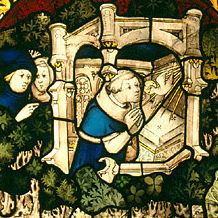Theory for Art Historians
Overview
This module is designed to both help you to become more aware of the rich complexity that is art history and to critically examine some wonderful texts that will assist you to challenge some of the more widespread and commonly held assumptions about artists, artworks, the practice of interpretation, and the discipline of art history. By focussing in detail on two or three texts per session, the course is designed to hone your close reading skills and powers of literary, critical and rhetorical analysis, as well as your powers of verbal argumentation through discussion of these texts in class. At the same time, the course is designed to explore ways in which art history is a constantly shifting, endlessly changing practice, itself culturally contingent, rather than a set of universalist practices or rules.
Aims
By the end of the module, you should have developed:
- A critical knowledge of 8 carefully chosen problems central to art historical writing and thinking today.
- A critical awareness of the ways in which theory is implicated in art history.
- A greater awareness of the challenge and productiveness of engaging with difficult texts.
- A developing awareness of your own implication in art history’s exclusionary practices.
Preliminary reading
We strongly recommend that for this module you purchase a copy of:
- Robert S.Nelson and Richard Shiff, eds, Critical Terms for Art History, 2nd ed. (1996; Chicago, 2003)
This book provides a set of essays on key themes in art history, written by leading scholars. Several of these essays will be recommended reading throughout the term, and for copyright reasons it will not be possible to make these available digitally, so it will be to your great advantage to have your own copy. It is available for under £20 in paperback and as a Kindle book. Please be sure to buy the second edition, 2003, rather than the first edition of 1996, as some of the essays we recommend are not included in the first edition.
Other overviews of theoretical approaches used in art history which you may find useful as supplementary or preliminary reading include:
- Anne D’Alleva, Methods and Theories for Art History, 2nd ed. (1995; London, 2012)
- Laurie Schneider Adams, The Methodologies of Art: An Introduction, 2nd ed. (1996; Boulder, 2009)
- Michael Hatt and Charlotte Klonk, Art History: A Critical Introduction to its Methods (Manchester, 2006)
- Jae Emerling, Theory for Art History (New York and London, 2006)

Module information
- Module title
Theory for Art Historians- Module number
HOA00002C
For undergraduates
- Handbook
- Current Modules
- Exams and assessment
- Study Abroad
- Resources
- Student activities
